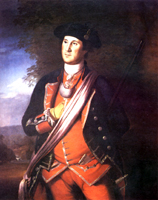
| Home | Inn | Mill | Products | Community | History | Attractions | Events | Contact | Site Map |
 |
|||||||||||||
|
|||||||||||||
| George Washington in Belmont County, Ohio - 1770 | ||||||||||||

by C. Edward Wall In 1770, George Washington explored the Ohio River valley, describing the country -- as seen from his canoe and from campsites along the Ohio River. On 22 October, he reached Mingo Town (now Mingo Junction, Ohio) which is just north of Belmont County, Ohio. Washington said in his diary that "This place contains abt. Twenty Cabbins, & 70 Inhabitants of the Six Nation [Iroquois Confederation]." ["Mingo" is a slang term used to describe Iroquois Indians living outside their main area of control.] At Mingo Town, Washington found "60 odd Warriors of the Six Nations going to the Cherokee Country to proceed to War against the Cuttawba's." While encamped there, Washington also received news that two traders had been killed by Indians about 28 miles downriver -- at what today is Powhatton, Ohio. On the 23rd, several more accounts of the killings reached Mingo Town, but these accounts suggested that only one white man was killed, and that it was not at the hands of the Indians. Thus, about 2 o'clock in the afternoon, Washington and his companions -- including two Indian guides -- set off down river, making there camp for the night on the Virginia side of the Ohio River at Fishing Creek. The next morning -- 24 October, Washington writes that they left their encampment before sunrise. He then procedes to describe the land and streams entering the Ohio River. He states, "we came to another Creek on the West side, calld by Nicholson Weeling [McMahon's Creek] and abt. a Mile lower down appears to be another small Water coming in on the East side [McMahon Run], which I remark, because of the Scarcity of them; fie to shew how badly furnishd this Country is with Mill Seats. Two or three Miles below this again, is another Run on the West side; up which is a near way by Land to the Mingo Town; and about 4 Miles lower comes in another on the East at which place is a path leading to the settlement at Redstone. Abt. A Mile & half below this again, comes in the Pipe Creek [in Belmont County, several miles north of Captina Creek] so calld by the Indians from a Stone which is found here out of which they make Pipes. Opposite to this (that is on the East side), is a bottom of exceeding Rich Land; but as it seems to lye low, I am apprehensive that it is subject to be overflowd. This Bottom ends where the effects of a hurricane appears by the destruction & havock among the Trees. [Washington later secured ownership of the land near Pipe Creek in Belmont County, Ohio.] His diary continues: "Two or three Miles below the Pipe Creek is a pretty large Creek on the West side calld by Nicholson Fox Grape Vine -- by others Captema Creek on which, 8 Miles up it, is the Town calld the Grape Vine Town; & at the Mouth of it, is the place where it was said the Traders livd, & the one was killd. To this place [Powhatton Point] we came abt. 3 Oclock in the Afternoon, & findg. no body there, we agreed to Camp; that Nicholson and one of the Indians might go up to the Town, & enquire into the truth of the report concerning the Murder." Ascending Captina Creek (Grapevine Creek), Nicholson and the Indian did not return until the next day. Washington records Nicholson's report as follows: "Nicholson & the Indian returnd; they found no body at the [Grapevine] Town but two Old Indian women (the Men being a Hunting). From these they learnt that the Trader was not killd, but drownd in attempting to Ford the Ohio; and that only one boy, belonging to the Trader, was in these parts; the Trader (fathr. to him) being gone for Horses to take home their Skins. [Note: Today, the approximate location of Grapevine Town is still marked by grapevines, which hug the riverbank and canapy the road that follows Captina Creek.] Elsewhere in his Diary, Washington describes the weather for 22-25 October 1770 as blustery and cold. In 1796, George Washington advertised his land along Pipe Creek (in Belmont County, Ohio) for sale, and describes the land as: "Round Bottom ... about 15 miles below Wheeling, a little above Captenon, and opposite to Pipe-Creek; bounded by the river in a circular form for 2 miles and 120 poles containing 587 acres." For Washington's entire account of his 1770 travels in the Ohio River Valley, Please see George Washington's Papers at the Library of Congress, 1741-1799. See specifically: The Diaries of George Washington. Vol. 2. Donald Jackson, ed.; Dorothy Twohig, assoc. ed. The Papers of George Washington. Charlottesville: University Press of Virginia, 1976. Pages 295-298 of this resource record Washington's account of and contain related notes on the events for 22-25 October 1770. Caption: George Washignton as a Virginia Colonel. Painted by C.W. Peale in 1772.
|
||||||||||||
|
| Home |
Inn |
Mill |
Products |
Community | | History | Attractions | Contact | Site Map | Admin | |
|
|
Site: © 2002-2025 by: Pierian Press Web Services | Hosted by: Stratton House Inn Content: © 2002-2025 Stratton House Inn. All rights reserved. |